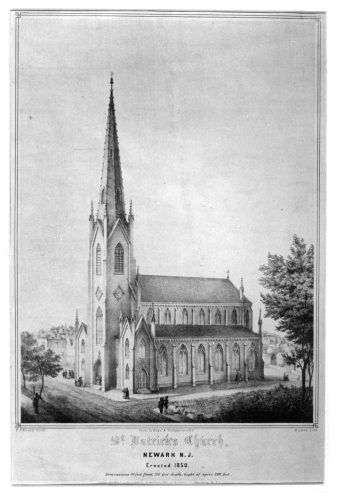
Courtesy of Newark Public Library
In the 1840s, a blight destroyed the potato crop in Ireland. The resultant famine, the “Great Hunger,” killed more than one million persons and drove more than one and a half million Irish to emigrate. Many came to the United States, thousands to New Jersey and to Newark. By the mid-1840s, there were over 1,500 Catholics in Newark. In 1850 the foreign-born population of New Jersey included over 31,000 Irish, most of them Catholic, and over 10,000 Germans, many Catholics among them. This sudden increase in the Catholic population of Newark strained the facilities of St. John’s Church on Mulberry Street. After proposals to enlarge the church were rejected, Bishop John Hughes of New York authorized Rev. Patrick Moran, pastor of St. John’s Parish, to build a new church.
Father Moran lived in a Newark that still had large wooded areas watered by brooks and streams. Where St. Patrick’s now stands there was a brook with good fishing. Folks hunted in the hollow along the hill that rises to High Street. Lighting in the homes was provided by candles and kerosene lamps. The streets would not be illuminated until 1852 when gas lighting was installed. Thomas Edison’s invention of the incandescent lamp was 30 years in the future. The horse and wagon were the prevailing mode of transportation in competition with the far from perfected and very expensive steam locomotive. Electric trolleys would not appear until 1888.
Father Moran immediately set to work. He was not discouraged by the poverty of so many of his flock, recently arrived from Ireland. He trusted in their generosity and would not be disappointed. Father Moran chose the corner of Washington and Nesbitt Streets, now Central Avenue, as the site for the new church. The land was part of the estate of Gen. Thomas Ward and was to be sold at public auction on Oct. 26, 1846. Because of prejudice against Catholics, Father Moran feared that, if it were known that the property was wanted as a site for a Catholic church, he would not be able to purchase it. He asked five parishioners to bid separately for the various parcels. They bought most of the land but were outbid on some of the lots by Mr. Norris, a wealthy Protestant, who lived on Washington Place. This situation took an unexpected and happy turn. Father Moran called on Mr. Norris and explained the situation. Norris said that had he known the lots were needed for a new church, he would not have bid on them. He sold the property to Father Moran at cost and also made a generous donation towards the building fund.
According to some accounts, Father Moran himself drew up the plans for the church. However, scholars have noted that the finished St. Patrick’s resembles the Church of Sts. Peter and Paul in the Williamsburg section of Brooklyn, designed by architect Patrick C. Keely and completed in 1848. This has led them to attribute the design to Keely. One scholar has written that “it was through the kind interest of Father Patrick Moran that Mr. Keeley (sic) obtained the Newark work which secured for him the drawing up of a design for St. Patrick’s.” Although Moran had designed extensive alterations to St. John’s Church, it is difficult to imagine that a plan as complex as St. Patrick’s could have come from anyone other than a professional architect. It seems likely that Keely drew up the plans, incorporating suggestions from Moran.
Moran quickly signed a contract with a builder. Disaster struck the week before the bishop was to come to lay the cornerstone. Late one evening word came to the pastor that the contractor had absconded with the funds for the church. Moran was left with bills for lumber, brick, and wages to the workmen. His parishioners quickly raised the necessary money and work on the new church began again. Bishop Hughes laid the cornerstone on Sept. 17, 1848. While Father Moran oversaw the construction, he left all details and fundraising in the hands of his assistant, Rev. Louis Dominic Senez. Father Senez worked tirelessly and the people contributed generously. Finally, the church was completed and Father Senez was named the first pastor of St. Patrick’s Church.
« Prologue | The Parish »